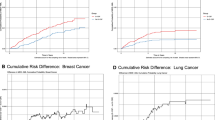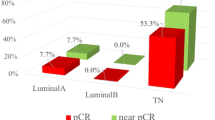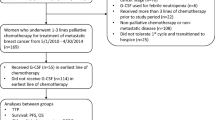Abstract
Risk of myelodysplastic syndrome (MDS) and acute myeloid leukemia (AML) post-breast cancer treatment with adjuvant chemotherapy and granulocyte colony-stimulating factors (G-CSF) is not fully characterized. Our objective was to estimate MDS/AML risk associated with specific breast cancer treatments. We conducted a retrospective cohort study of women aged ≥66 years with stage I–III breast cancer between 2001 and 2009 using the Surveillance, Epidemiology, and End Results-Medicare database. Women were classified as receiving treatment with radiation, chemotherapy, and/or G-CSF. We used multivariable Cox proportional hazards models to estimate adjusted hazard ratios (HR) and 95 % confidence intervals (CI) for MDS/AML risk. Among 56,251 breast cancer cases, 1.2 % developed MDS/AML during median follow-up of 3.2 years. 47.1 % of women received radiation and 14.3 % received chemotherapy. Compared to breast cancer cases treated with surgery alone, those treated with chemotherapy (HR = 1.38, 95 %-CI 0.98–1.93) and chemotherapy/radiation (HR = 1.77, 95 %-CI 1.25–2.51) had increased risk of MDS/AML, but not radiation alone (HR = 1.08, 95 % CI 0.86–1.36). Among chemotherapy regimens and G-CSF, MDS/AML risk was differentially associated with anthracycline/cyclophosphamide-containing regimens (HR = 1.86, 95 %-CI 1.33–2.61) and filgrastim (HR = 1.47, 95 %-CI 1.05–2.06), but not pegfilgrastim (HR = 1.10, 95 %-CI 0.73–1.66). We observed increased MDS/AML risk among older breast cancer survivors treated with anthracycline/cyclophosphamide chemotherapy that was enhanced by G-CSF. Although small, this risk warrants consideration when determining adjuvant chemotherapy and neutropenia prophylaxis for breast cancer patients.



Similar content being viewed by others
References
Godley LA, Larson RA (2008) Therapy-related myeloid leukemia. Semin Oncol 35(4):418–429. doi:10.1053/j.seminoncol.2008.04.012
Larson RA (2007) Etiology and management of therapy-related myeloid leukemia. Hematol Am Soc Hematol Educ Program. doi:10.1182/asheducation-2007.1.453
Wolff AC, Blackford AL, Visvanathan K, Rugo HS, Moy B, Goldstein LJ, Stockerl-Goldstein K, Neumayer L, Langbaum TS, Theriault RL, Hughes ME, Weeks JC, Karp JE (2015) Risk of marrow neoplasms after adjuvant breast cancer therapy: the national comprehensive cancer network experience. J Clin Oncol 33(4):340–348. doi:10.1200/JCO.2013.54.6119
Patt DA, Duan Z, Fang S, Hortobagyi GN, Giordano SH (2007) Acute myeloid leukemia after adjuvant breast cancer therapy in older women: understanding risk. J Clin Oncol 25(25):3871–3876. doi:10.1200/JCO.2007.12.0832
Praga C, Bergh J, Bliss J, Bonneterre J, Cesana B, Coombes RC, Fargeot P, Folin A, Fumoleau P, Giuliani R, Kerbrat P, Hery M, Nilsson J, Onida F, Piccart M, Shepherd L, Therasse P, Wils J, Rogers D (2005) Risk of acute myeloid leukemia and myelodysplastic syndrome in trials of adjuvant epirubicin for early breast cancer: correlation with doses of epirubicin and cyclophosphamide. J Clin Oncol 23(18):4179–4191. doi:10.1200/JCO.2005.05.029
Smith RE, Bryant J, DeCillis A, Anderson S (2003) Acute myeloid leukemia and myelodysplastic syndrome after doxorubicin-cyclophosphamide adjuvant therapy for operable breast cancer: the National Surgical Adjuvant Breast and Bowel Project Experience. J Clin Oncol 21(7):1195–1204
Kaplan H, Malmgren J, De Roos AJ (2013) Risk of myelodysplastic syndrome and acute myeloid leukemia post radiation treatment for breast cancer: a population-based study. Breast Cancer Res Treat 137(3):863–867. doi:10.1007/s10549-012-2386-9
Kaplan HG, Malmgren JA, Atwood MK (2011) Increased incidence of myelodysplastic syndrome and acute myeloid leukemia following breast cancer treatment with radiation alone or combined with chemotherapy: a registry cohort analysis 1990–2005. BMC Cancer 11:260. doi:10.1186/1471-2407-11-260
Felix CA (1998) Secondary leukemias induced by topoisomerase-targeted drugs. Biochim Biophys Acta 1400(1–3):233–255
Pedersen-Bjergaard J, Pedersen M, Roulston D, Philip P (1995) Different genetic pathways in leukemogenesis for patients presenting with therapy-related myelodysplasia and therapy-related acute myeloid leukemia. Blood 86(9):3542–3552
Du XL, Lairson DR, Begley CE, Fang S (2005) Temporal and geographic variation in the use of hematopoietic growth factors in older women receiving breast cancer chemotherapy: findings from a large population-based cohort. J Clin Oncol 23(34):8620–8628. doi:10.1200/JCO.2005.02.6252
Hershman D, Neugut AI, Jacobson JS, Wang J, Tsai WY, McBride R, Bennett CL, Grann VR (2007) Acute myeloid leukemia or myelodysplastic syndrome following use of granulocyte colony-stimulating factors during breast cancer adjuvant chemotherapy. J Natl Cancer Inst 99(3):196–205. doi:10.1093/jnci/djk028
Lyman GH, Dale DC, Wolff DA, Culakova E, Poniewierski MS, Kuderer NM, Crawford J (2010) Acute myeloid leukemia or myelodysplastic syndrome in randomized controlled clinical trials of cancer chemotherapy with granulocyte colony-stimulating factor: a systematic review. J Clin Oncol 28(17):2914–2924. doi:10.1200/JCO.2009.25.8723
Lyman GH (2005) Guidelines of the National Comprehensive Cancer Network on the use of myeloid growth factors with cancer chemotherapy: a review of the evidence. J Natl Compr Cancer Netw 3(4):557–571
Smith TJ, Khatcheressian J, Lyman GH, Ozer H, Armitage JO, Balducci L, Bennett CL, Cantor SB, Crawford J, Cross SJ, Demetri G, Desch CE, Pizzo PA, Schiffer CA, Schwartzberg L, Somerfield MR, Somlo G, Wade JC, Wade JL, Winn RJ, Wozniak AJ, Wolff AC (2006) 2006 update of recommendations for the use of white blood cell growth factors: an evidence-based clinical practice guideline. J Clin Oncol 24(19):3187–3205. doi:10.1200/JCO.2006.06.4451
Aapro MS, Bohlius J, Cameron DA, Dal Lago L, Donnelly JP, Kearney N, Lyman GH, Pettengell R, Tjan-Heijnen VC, Walewski J, Weber DC, Zielinski C, European Organisation for R, Treatment of C (2011) 2010 update of EORTC guidelines for the use of granulocyte-colony stimulating factor to reduce the incidence of chemotherapy-induced febrile neutropenia in adult patients with lymphoproliferative disorders and solid tumours. Eur J Cancer 47(1):8–32. doi:10.1016/j.ejca.2010.10.013
Rajan SS, Stearns SC, Lyman GH, Carpenter WR (2011) Effect of primary prophylactic G-CSF use on systemic therapy administration for elderly breast cancer patients. Breast Cancer Res Treat 130(1):255–266. doi:10.1007/s10549-011-1553-8
Kaushansky K (2006) Lineage-specific hematopoietic growth factors. N Engl J Med 354(19):2034–2045. doi:10.1056/NEJMra052706
Citron ML, Berry DA, Cirrincione C, Hudis C, Winer EP, Gradishar WJ, Davidson NE, Martino S, Livingston R, Ingle JN, Perez EA, Carpenter J, Hurd D, Holland JF, Smith BL, Sartor CI, Leung EH, Abrams J, Schilsky RL, Muss HB, Norton L (2003) Randomized trial of dose-dense versus conventionally scheduled and sequential versus concurrent combination chemotherapy as postoperative adjuvant treatment of node-positive primary breast cancer: first report of Intergroup Trial C9741/Cancer and Leukemia Group B Trial 9741. J Clin Oncol 21(8):1431–1439. doi:10.1200/JCO.2003.09.081
Kaplan HG, Malmgren JA, Li CI, Calip GS (2013) Age related risk of myelodysplastic syndrome and acute myeloid leukemia among breast cancer survivors. Breast Cancer Res Treat 142(3):629–636. doi:10.1007/s10549-013-2773-x
Martin MG, Welch JS, Luo J, Ellis MJ, Graubert TA, Walter MJ (2009) Therapy related acute myeloid leukemia in breast cancer survivors, a population-based study. Breast Cancer Res Treat 118(3):593–598. doi:10.1007/s10549-009-0376-3
Schumock GT, Li EC, Suda KJ, Matusiak LM, Hunkler RJ, Vermeulen LC, Hoffman JM (2014) National trends in prescription drug expenditures and projections for 2014. Am J Health-Syst Pharm 71(6):482–499. doi:10.2146/ajhp130767
Surveillance Epidemiology and End Results (SEER) Program Overview of the SEER Program http://seer.cancer.gov/about/overview.html
Warren JL, Klabunde CN, Schrag D, Bach PB, Riley GF (2002) Overview of the SEER-Medicare data: content, research applications, and generalizability to the United States elderly population. Med Care 40(8 Suppl):IV-3–IV-18. doi:10.1097/01.MLR.0000020942.47004.03
Singletary SE, Allred C, Ashley P, Bassett LW, Berry D, Bland KI, Borgen PI, Clark GM, Edge SB, Hayes DF, Hughes LL, Hutter RV, Morrow M, Page DL, Recht A, Theriault RL, Thor A, Weaver DL, Wieand HS, Greene FL (2003) Staging system for breast cancer: revisions for the 6th edition of the AJCC Cancer Staging Manual. Surg Clin N Am 83(4):803–819. doi:10.1016/S0039-6109(03)00034-3
Chubak J, Boudreau DM, Wirtz HS, McKnight B, Weiss NS (2013) Threats to validity of nonrandomized studies of postdiagnosis exposures on cancer recurrence and survival. J Natl Cancer Inst 105(19):1456–1462. doi:10.1093/jnci/djt211
Deyo RA, Cherkin DC, Ciol MA (1992) Adapting a clinical comorbidity index for use with ICD-9-CM administrative databases. J Clin Epidemiol 45(6):613–619
Klabunde CN, Potosky AL, Legler JM, Warren JL (2000) Development of a comorbidity index using physician claims data. J Clin Epidemiol 53(12):1258–1267
Bikov KA, Mullins CD, Seal B, Onukwugha E, Hanna N (2013) Algorithm for identifying chemotherapy/biological regimens for metastatic colon cancer in SEER-medicare. Med Care. doi:10.1097/MLR.0b013e31828fad9f
Ma X, Does M, Raza A, Mayne ST (2007) Myelodysplastic syndromes: incidence and survival in the United States. Cancer 109(8):1536–1542. doi:10.1002/cncr.22570
Cogle CR, Craig BM, Rollison DE, List AF (2011) Incidence of the myelodysplastic syndromes using a novel claims-based algorithm: high number of uncaptured cases by cancer registries. Blood 117(26):7121–7125. doi:10.1182/blood-2011-02-337964
Wakeford R (2004) The cancer epidemiology of radiation. Oncogene 23(38):6404–6428. doi:10.1038/sj.onc.1207896
Curtis RE, Boice JD Jr, Stovall M, Bernstein L, Greenberg RS, Flannery JT, Schwartz AG, Weyer P, Moloney WC, Hoover RN (1992) Risk of leukemia after chemotherapy and radiation treatment for breast cancer. N Engl J Med 326(26):1745–1751. doi:10.1056/NEJM199206253262605
Campone M, Roche H, Kerbrat P, Bonneterre J, Romestaing P, Fargeot P, Namer M, Monnier A, Montcuquet P, Goudier MJ, Fumoleau P (2005) Secondary leukemia after epirubicin-based adjuvant chemotherapy in operable breast cancer patients: 16 years experience of the French Adjuvant Study Group. Ann Oncol 16(8):1343–1351. doi:10.1093/annonc/mdi251
Roche H, Fumoleau P, Spielmann M, Canon JL, Delozier T, Serin D, Symann M, Kerbrat P, Soulie P, Eichler F, Viens P, Monnier A, Vindevoghel A, Campone M, Goudier MJ, Bonneterre J, Ferrero JM, Martin AL, Geneve J, Asselain B (2006) Sequential adjuvant epirubicin-based and docetaxel chemotherapy for node-positive breast cancer patients: the FNCLCC PACS 01 Trial. J Clin Oncol 24(36):5664–5671. doi:10.1200/JCO.2006.07.3916
Jones S, Holmes FA, O’Shaughnessy J, Blum JL, Vukelja SJ, McIntyre KJ, Pippen JE, Bordelon JH, Kirby RL, Sandbach J, Hyman WJ, Richards DA, Mennel RG, Boehm KA, Meyer WG, Asmar L, Mackey D, Riedel S, Muss H, Savin MA (2009) Docetaxel with cyclophosphamide is associated with an overall survival benefit compared with doxorubicin and cyclophosphamide: 7-year follow-up of US Oncology Research Trial 9735. J Clin Oncol 27(8):1177–1183. doi:10.1200/JCO.2008.18.4028
Burnell M, Levine MN, Chapman JA, Bramwell V, Gelmon K, Walley B, Vandenberg T, Chalchal H, Albain KS, Perez EA, Rugo H, Pritchard K, O’Brien P, Shepherd LE (2010) Cyclophosphamide, epirubicin, and fluorouracil versus dose-dense epirubicin and cyclophosphamide followed by paclitaxel versus doxorubicin and cyclophosphamide followed by paclitaxel in node-positive or high-risk node-negative breast cancer. J Clin Oncol 28(1):77–82. doi:10.1200/JCO.2009.22.1077
Tallman MS, Gray R, Bennett JM, Variakojis D, Robert N, Wood WC, Rowe JM, Wiernik PH (1995) Leukemogenic potential of adjuvant chemotherapy for early-stage breast cancer: the Eastern Cooperative Oncology Group experience. J Clin Oncol 13(7):1557–1563
Amgen, Inc. (2013) Neupogen (product monograph). Thousand Oaks: Amgen, Inc
Dong F, Brynes RK, Tidow N, Welte K, Lowenberg B, Touw IP (1995) Mutations in the gene for the granulocyte colony-stimulating-factor receptor in patients with acute myeloid leukemia preceded by severe congenital neutropenia. N Engl J Med 333(8):487–493. doi:10.1056/NEJM199508243330804
Rosenberg PS, Alter BP, Bolyard AA, Bonilla MA, Boxer LA, Cham B, Fier C, Freedman M, Kannourakis G, Kinsey S, Schwinzer B, Zeidler C, Welte K, Dale DC, Severe Chronic Neutropenia International R (2006) The incidence of leukemia and mortality from sepsis in patients with severe congenital neutropenia receiving long-term G-CSF therapy. Blood 107(12):4628–4635. doi:10.1182/blood-2005-11-4370
Touw IP, Bontenbal M (2007) Granulocyte colony-stimulating factor: key (f)actor or innocent bystander in the development of secondary myeloid malignancy? J Natl Cancer Inst 99(3):183–186. doi:10.1093/jnci/djk057
Naparstek E (1995) Granulocyte colony-stimulating factor, congenital neutropenia, and acute myeloid leukemia. N Engl J Med 333(8):516–518. doi:10.1056/NEJM199508243330811
Shapira MY, Kaspler P, Samuel S, Shoshan S, Or R (2003) Granulocyte colony stimulating factor does not induce long-term DNA instability in healthy peripheral blood stem cell donors. Am J Hematol 73(1):33–36. doi:10.1002/ajh.10324
Confer DL, Miller JP (2007) Long-term safety of filgrastim (rhG-CSF) administration. Br J Haematol 137 (1):77–78; author reply 79–80. doi:10.1111/j.1365-2141.2007.06524.x
Bennett CL, Evens AM, Andritsos LA, Balasubramanian L, Mai M, Fisher MJ, Kuzel TM, Angelotta C, McKoy JM, Vose JM, Bierman PJ, Kuter DJ, Trifilio SM, Devine SM, Tallman MS (2006) Haematological malignancies developing in previously healthy individuals who received haematopoietic growth factors: report from the Research on Adverse Drug Events and Reports (RADAR) project. Br J Haematol 135(5):642–650. doi:10.1111/j.1365-2141.2006.06312.x
Shaw BE, Confer DL, Hwang W, Pulsipher MA (2015) A review of the genetic and long-term effects of G-CSF injections in healthy donors: a reassuring lack of evidence for the development of haematological malignancies. Bone Marrow Transplant 50(3):334–340. doi:10.1038/bmt.2014.278
Slovak ML, Bedell V, Lew D, Albain KS, Ellis GK, Livingston RB, Martino S, Perez EA, Hortobagyi GN, Sher D, Stock W (2010) Screening for clonal hematopoiesis as a predictive marker for development of therapy-related myeloid neoplasia (t-MN) following neoadjuvant therapy for breast cancer: a Southwest Oncology Group study (S0012). Breast Cancer Res Treat 119(2):391–398. doi:10.1007/s10549-009-0597-5
Amgen, Inc. (2013) Neulasta (product monograph). Thousand Oaks: Amgen, Inc
Molineux G, Arvedson T, Foote M (2012) Twenty years of G-CSF: clinical and nonclinical discoveries. Milestones in drug therapy. Springer, Basel
Rizzieri DA, O’Brien JA, Broadwater G, Decastro CM, Dev P, Diehl L, Beaven A, Lagoo A, Gockerman JP, Chao NJ, Moore JO (2009) Outcomes of patients who undergo aggressive induction therapy for secondary acute myeloid leukemia. Cancer 115(13):2922–2929. doi:10.1002/cncr.24379
Kroger N, Brand R, van Biezen A, Cahn JY, Slavin S, Blaise D, Sierra J, Zander A, Niederwieser D, de Witte T, Myelodysplastic Syndromes Subcommittee of The Chronic Leukaemia Working Party of the European Group for B, Marrow T (2006) Autologous stem cell transplantation for therapy-related acute myeloid leukemia and myelodysplastic syndrome. Bone Marrow Transplant 37(2):183–189. doi:10.1038/sj.bmt.1705226
Anderson JE, Gooley TA, Schoch G, Anasetti C, Bensinger WI, Clift RA, Hansen JA, Sanders JE, Storb R, Appelbaum FR (1997) Stem cell transplantation for secondary acute myeloid leukemia: evaluation of transplantation as initial therapy or following induction chemotherapy. Blood 89(7):2578–2585
Early Breast Cancer Trialists’ Collaborative G (2005) Effects of chemotherapy and hormonal therapy for early breast cancer on recurrence and 15-year survival: an overview of the randomised trials. Lancet 365(9472):1687–1717. doi:10.1016/S0140-6736(05)66544-0
Acknowledgments
This work was supported, in part, by the National Institutes of Health (Contract Number HHSN2612013000121 to the Fred Hutchinson Cancer Research Center) and the Kaplan Cancer Research Fund (J.A.M. and H.G.K.). Author G.S.C. was supported by the National Institutes of Health Cancer Prevention Training Grant in Nutrition, Exercise and Genetics at the University of Washington (R25CA094880).
Author Contributions
G.S.C., J.A.M., S.M.S., and H.G.K. conceived and designed the study; G.S.C., J.A.M., W.J.L., and S.M.S. collected and assembled the data, developed the algorithms, and performed the statistical analyses; all authors interpreted the results and read and commented on the article.
Disclaimers
This study used the linked SEER-Medicare database. The interpretation and reporting of these data are the sole responsibility of the authors. The authors acknowledge the efforts of the Applied Research Program, NCI; the Office of Research, Development and Information, CMS; Information Management Services (IMS), Inc.; and the Surveillance, Epidemiology, and End Results (SEER) Program tumor registries in the creation of the SEER-Medicare database.
Author information
Authors and Affiliations
Corresponding author
Ethics declarations
Conflict of interest
The authors declare no conflict of interest.
Electronic supplementary material
Below is the link to the electronic supplementary material.
Rights and permissions
About this article
Cite this article
Calip, G.S., Malmgren, J.A., Lee, WJ. et al. Myelodysplastic syndrome and acute myeloid leukemia following adjuvant chemotherapy with and without granulocyte colony-stimulating factors for breast cancer. Breast Cancer Res Treat 154, 133–143 (2015). https://doi.org/10.1007/s10549-015-3590-1
Received:
Accepted:
Published:
Issue Date:
DOI: https://doi.org/10.1007/s10549-015-3590-1




